

|
◆ Directory:◆ Foreword One Foreword Two Translator’s Foreword Chapter 1: Ubuntu Linux for Robots 1.1 Introduction to GNU/Linux 1.2 Installing Ubuntu 1.3 Ubuntu File System 1.4 Introduction to Shell Commands 1.5 Chapter Summary Chapter 2: Basic Knowledge of C++ for Robot Programming 2.1 Introduction to C++ 2.2 Running C/C++ in Ubuntu Linux 2.3 Learning OOP Concepts from Examples 2.4 Creating a C++ Project 2.5 Chapter Summary Chapter 3: Basic Python for Robot Programming 3.1 Getting Started with Python 3.2 Python in Ubuntu/Linux 3.3 Chapter Summary Chapter 4: Overview of ROS 4.1 What is Robot Programming 4.2 Why Robot Programming is Unique 4.3 Getting Started with ROS 4.4 Chapter Summary Chapter 5: ROS Programming 5.1 What is Programming with ROS 5.2 Creating ROS Workspaces and Packages 5.3 Using ROS Client Libraries 5.4 Programming Embedded Boards with ROS 5.5 Chapter Summary Chapter 6: ROS-Based Robot Projects 6.1 Starting with Wheeled Robots 6.2 Kinematics of Differential Drive Robots 6.3 Building Robot Hardware 6.4 Creating a 3D ROS Model with URDF 6.5 Writing Robot Firmware 6.6 Programming Robots with ROS 6.7 Final Run 6.8 Chapter Summary |
